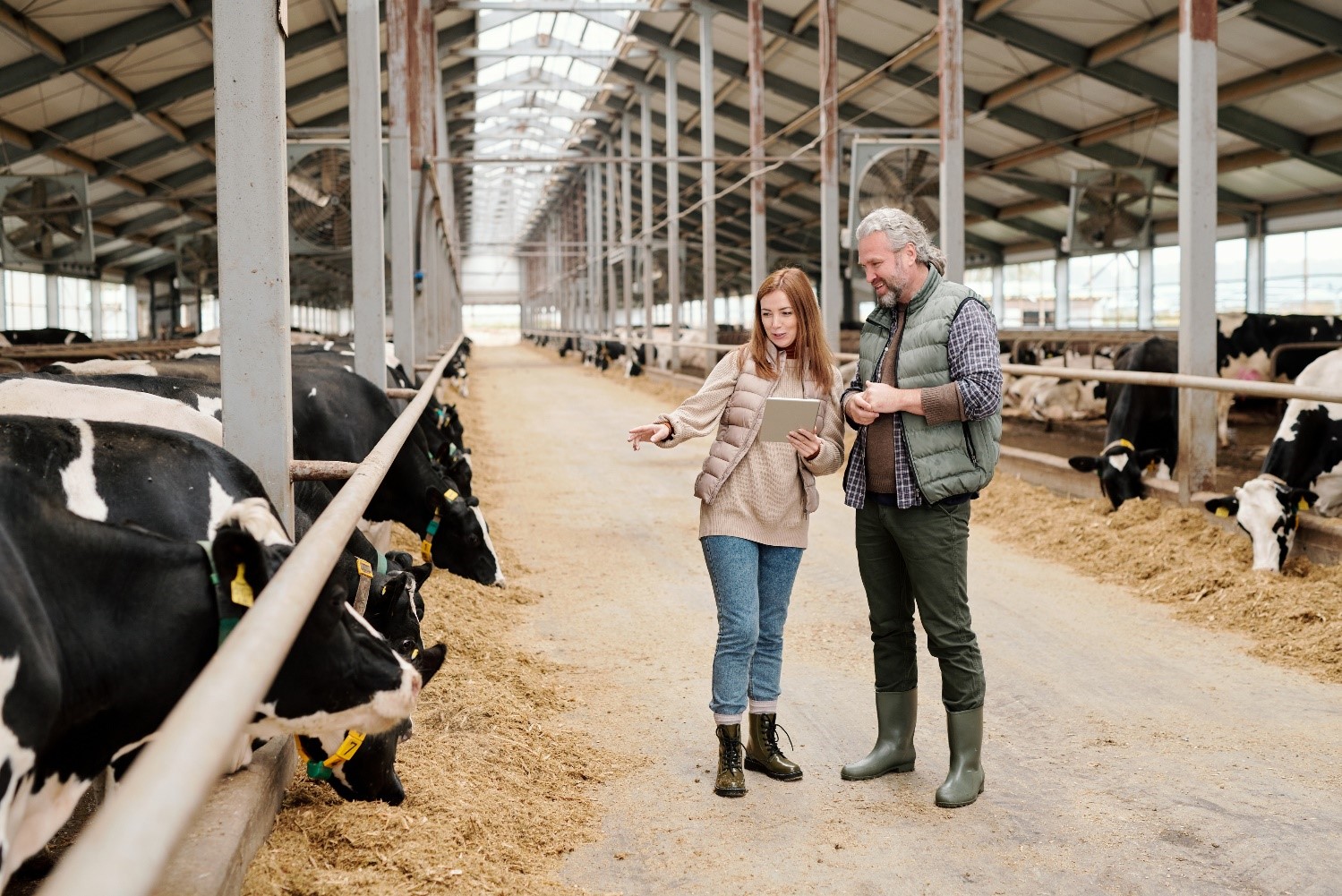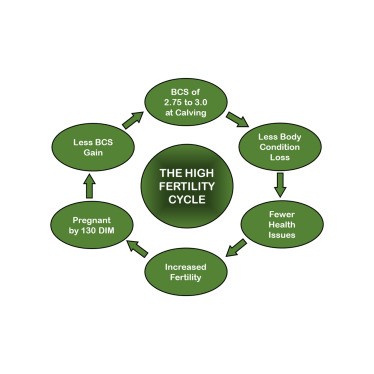A new mini-review in JDS Communications® breaks down how timely pregnancies can lead to better body condition, fewer health issues, and a sustained healthy cycle of fertility
Philadelphia, May 10, 2023 – The dairy industry has seen a revolution over the past two decades in fertility success within herds. Widely adopted fertility programs are at the heart of this leap forward, along with the industry’s increased understanding—and optimization—of the holistic interactions among the body condition, overall health, and fertility of a dairy cow. In a recent mini-review appearing in a special fertility issue of JDS Communications®, published by Elsevier, researchers from the University of Wisconsin Madison and Michigan State University synthesize the past three decades of scientific research explaining these relationships and highlight the key actionable takeaways for establishing and maintaining high fertility for a dairy herd.
Richard Pursley, PhD, of Michigan State University, one of the co-authors, initially coined the term “high fertility cycle” to describe this understanding of the interrelated factors on a dairy farm that interact to create fertility success.
“After the last two or more decades of research,” explained Pursley, “we now know that reproductive success is tied to other health markers in a dairy herd, and we set out to show how this knowledge can be utilized to maximize a herd’s fertility rate through easy, applicable changes in production management on the farm.”

Caption: Simple management changes can help get and maintain an optimal cycle of high fertility (Credit: iStock.com/shironosov).
The authors combed back through three decades of dairy research to present the essential knowledge on this topic in their mini-review. They start by establishing the relationship between fertility and the body condition score (BCS)—a consistent 5-point scoring system in .25 increments long used as a practical management tool for Holstein cows to understand their body fat or energy stores.
“Healthier postpartum cows we know from the research have improved embryo quality, have greater fertility at first insemination, and see fewer early pregnancy losses after becoming pregnant,” said co-author Paul Fricke, PhD, of the University of Wisconsin–Madison. In addition, BCS loss after calving was associated with increased health issues, whereas maintaining or gaining BCS after calving was connected to fewer recorded health events, including metritis, mastitis, ketosis, and pneumonia.

Caption: The high fertility cycle describes the relationship among body condition score (BCS) change, health, and overall fertility (Credit: Paul M. Fricke, Milo C. Wiltbank, and J. Richard Pursley).
So, how can dairy farms ensure their herds maintain or gain BCS after calving to achieve healthy cows and high rates of fertility? The research shows that the critical factor is calving cows at a lower BCS between 2.75 and 3.0, which can be achieved by implementing an aggressive reproductive management program. Getting cows pregnant quickly after the end of the voluntary waiting period ensures a lower BCS at calving, which leads to less body condition loss after calving, and therefore healthier cows that are more fertile and better able to become pregnant again, restarting the cycle.
“The goal of every farm should be to strive to get as many cows as possible pregnant by 130 days in milk in order to achieve and maintain this critical high fertility cycle,” explained Fricke.
After reviewing the data, the team pinpointed key considerations for achieving and maintaining a high fertility cycle:
- Implement BCS monitoring for transition cows 3 weeks before calving, at calving, and 3 weeks after calving, as well as at artificial insemination,
- Use fertility programs to help establish pregnancy quickly after the end of the voluntary waiting period,
- Set a cutoff for the number of times individual cows will be inseminated, and
- Consider nutritional strategies to prevent late-lactation cows from gaining too much body condition.
The authors were careful to clarify that more research is needed to more directly link these relationships between BCS change and fertility in lactating dairy cows. The dairy science community is always striving to discover management techniques that continuously improve profitability as well as the health, longevity, and well-being of dairy cows. For those interested in the discussion, co-author Paul Fricke, PhD, will be presenting on reproductive decision making at the American Dairy Science Association’s 45th Discover Conference taking place on October 23–26, 2023. In the meantime, these insights and the key takeaways for the high fertility cycle offer a new management paradigm that that can be easily implemented and monitored on commercial dairy farms and have an immediate impact on reproduction and lactation success.
Notes for editors
The article is “The high fertility cycle,” by Paul M. Fricke, Milo C. Wiltbank, and J. Richard Pursley (https://doi.org/10.3168/jdsc.2022-0280). It appears in JDS Communications, volume 4, issue 2 (March/April 2023), published by FASS Inc. and Elsevier.
The article is openly available at https://www.jdscommun.org/article/S2666-9102(22)00114-4/fulltext, and the PDF version is available at https://www.jdscommun.org/action/showPdf?pii=S2666-9102%2822%2900114-4.
Journalists wishing to interview the authors should contact the corresponding author, Paul M. Fricke, PhD, University of Wisconsin–Madison Department of Animal and Dairy Sciences, at pmfricke@wisc.edu.
About JDS Communications
JDS Communications®, an official journal of the American Dairy Science Association®, is co-published by Elsevier and FASS Inc. for the American Dairy Science Association. The journal publishes narrowly focused, hypothesis-driven original research studies designed to answer a specific question on the production or processing of milk or milk products intended for human consumption. In addition to short research articles, JDS Communications publishes mini reviews—unsolicited, concise review papers. Research published in this journal is broadly divided into the production of milk from food animals (nutrition, physiology, health, genetics, and management) and processing of milk for human consumption (dairy foods). JDS Communications aims for rapid turnaround and a short time to publication. www.jdscommun.org
About the American Dairy Science Association (ADSA®)
The American Dairy Science Association (ADSA) is an international organization of educators, scientists, and industry representatives who are committed to advancing the dairy industry and keenly aware of the vital role the dairy sciences play in fulfilling the economic, nutritive, and health requirements of the world's population. It provides leadership in scientific and technical support to sustain and grow the global dairy industry through generation, dissemination, and exchange of information and services. Together, ADSA members have discovered new methods and technologies that have revolutionized the dairy industry.www.adsa.org
About FASS Inc.
Since 1998, FASS has provided shared management services to not-for-profit scientific organizations. With combined membership rosters of more than 10,000 professionals in animal agriculture and other sciences, FASS offers clients services in accounting, membership management, convention and meeting planning, information technology, and scientific publication support. The FASS publications department provides journal management, peer-review support, copyediting, and composition for this journal; the staff includes several BELS-certified (www.bels.org) technical editors and experienced composition staff. www.fass.org
About Elsevier
As a global leader in information and analytics, Elsevier helps researchers and healthcare professionals advance science and improve health outcomes for the benefit of society. We do this by facilitating insights and critical decision-making for customers across the global research and health ecosystems.
In everything we publish, we uphold the highest standards of quality and integrity. We bring that same rigor to our information analytics solutions for researchers, health professionals, institutions and funders.
Elsevier employs 8,700 people worldwide. We have supported the work of our research and health partners for more than 140 years. Growing from our roots in publishing, we offer knowledge and valuable analytics that help our users make breakthroughs and drive societal progress. Digital solutions such as ScienceDirect, Scopus, SciVal, ClinicalKey and Sherpath support strategic research management, R&D performance, clinical decision support, and health education. Researchers and healthcare professionals rely on our over 2,800 digitized journals, including The Lancet and Cell; our over 46,000+ eBook titles; and our iconic reference works, such as Gray's Anatomy. With the Elsevier Foundation and our external Inclusion & Diversity Advisory Board, we work in partnership with diverse stakeholders to advance inclusion and diversity in science, research and healthcare in developing countries and around the world.
Elsevier is part of RELX, a global provider of information-based analytics and decision tools for professional and business customers. www.elsevier.com